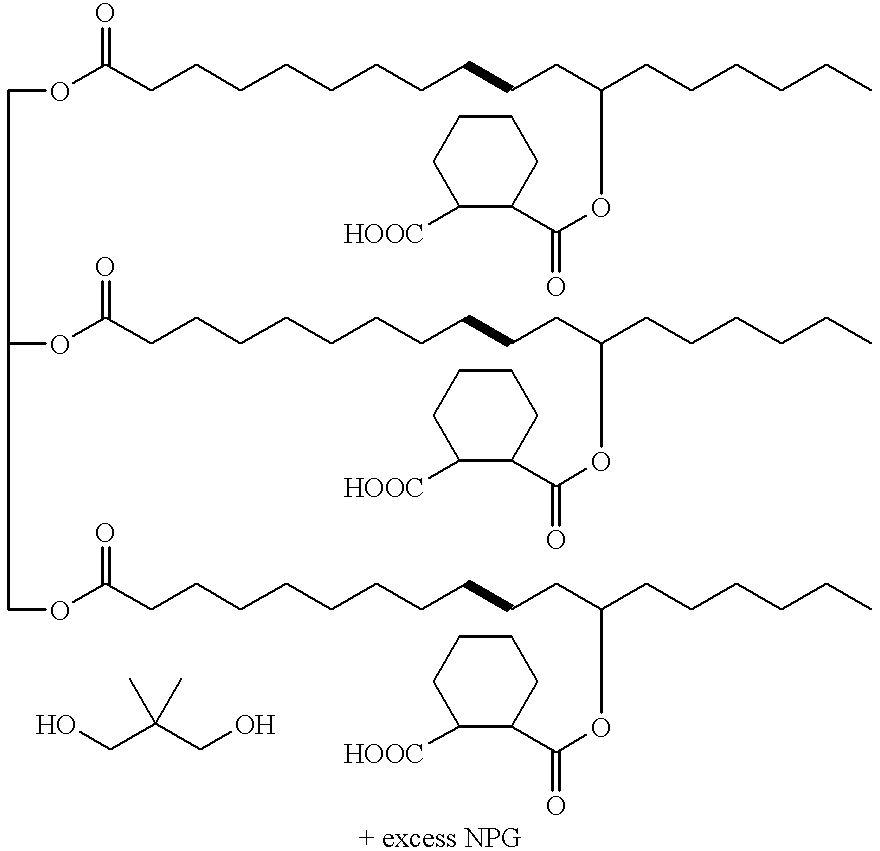Polyhydroxyl-compositions derived from castor oil with enhanced reactivity suitable for polyurethane-synthesis
a technology of polyhydroxyl compounds and castor oil, which is applied in the direction of polyurea/polyurethane adhesives, adhesive types, polyureas/polyurethane adhesives, etc., can solve the problems of relatively low reactivity of isocyanates, unsuitable reaction of above mentioned polyols, and the inability to achieve fast spraying systems in a very restricted scope, and achieves high hydrophobicity and high reactivity
- Summary
- Abstract
- Description
- Claims
- Application Information
AI Technical Summary
Benefits of technology
Problems solved by technology
Method used
Image
Examples
example 1
[0030]To a laboratory reactor with stirrer and distillation head, 940 g castor oil of quality “first pressing”, water content of at most 0.25%, were added. With stirring, 420 g hexahydrophthalic anhydride that were liquefied in a drying oven at 40° C. to 60° C. were added to said castor oil. Then 4 g zinc acetate were added as esterification catalyst and the mixture was heated to 180° C. within 20 minutes and with further stirring. The half ester formation between castor oil and hexahydrophthalic anhydride was then controlled at 180° C. by measuring the increase of viscosity (measurements with cone and plate viscosimeter at 23° C.). After about forty minutes of reaction time, the mixture reached a viscosity of 22'400 mpas.
[0031]320 g neopentylglycol and 320 g trimethylol-propane were added to said batch and a final esterificafion was performed during about 1½ hours at 245° C. to 250° C. During the reaction, about 70 ml condensate were removed by distillation. After cooling and bottl...
example 2
[0033]To a laboratory reactor with stirrer and distillation head, 920 g castor oil of quality “first pressing”, water content of at most 0.25%, were added, with stirring, 320 g succinic anhydride in powder form were added to said castor oil. Then 4 g esterification catalyst (antimony trioxide) were added and (in order to avoid too extensive sublimation of succinic anhydride in the reactor) the mixture was slowly heated to 170° C. within 20 minutes and with further stirring for half-ester formation. 720 g neopentyl glycol were added to said batch and a final esterification was performed during about 2 hours at 240° C. During the final esterification, about 80 ml distillate with a high content of neopentylglycol were collected. After cooling and bottling of the batch, a polyester polyol with the following specifications was obtained:
[0034]
Aspect:yellow, clear, viscous liquidKOH-value:261Hydroxyl equivalent:215 g / eq.Water content:Viscosity (23° C.)1′500 mPas
example 3
[0035]As described in Example 1 a half-ester synthesis was first performed, starting from 960 g castor oil, 440 g liquefied hexahydrophthalic anhydride and 4 g esterification catalyst.
[0036]Then about 480 g neopentylglycol and 120 g of granular pentaerythritol propane were added and a final esterification was performed during about 1½ hours at 245° C. to 250° C. While neopentylglycol readily dissolved, pentaerythritol remained undissolved until about 220° C. AT the end no bubble formation due to condensate cleavage (water) could be observed anymore. During cooling, at about 210° C. again about 5 ml distillate were removed under vacuum in order to improve the drying, such that a total of 76 ml distillate were collected. After cooling and bottling of the batch, a polyester polyol with the following specifications was obtained:
[0037]
Aspect:yellow, slightly turbid viscousliquidKOH-value:261Hydroxyl equivalent:215 g / eq.Water content:Viscosity (23° C.)10′000 mPas
PUM
| Property | Measurement | Unit |
|---|---|---|
| Temperature | aaaaa | aaaaa |
| Temperature | aaaaa | aaaaa |
| Temperature | aaaaa | aaaaa |
Abstract
Description
Claims
Application Information
 Login to View More
Login to View More - R&D Engineer
- R&D Manager
- IP Professional
- Industry Leading Data Capabilities
- Powerful AI technology
- Patent DNA Extraction
Browse by: Latest US Patents, China's latest patents, Technical Efficacy Thesaurus, Application Domain, Technology Topic, Popular Technical Reports.
© 2024 PatSnap. All rights reserved.Legal|Privacy policy|Modern Slavery Act Transparency Statement|Sitemap|About US| Contact US: help@patsnap.com










